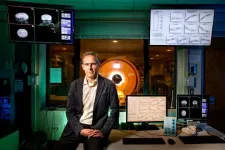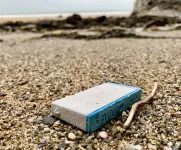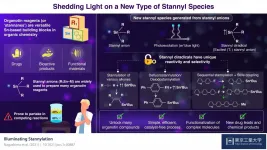(Press-News.org) CHAMPAIGN, Ill. -- Researchers have created a new, open-access tool that allows doctors and scientists to evaluate infant brain health by assessing the concentration of various chemical markers, called metabolites, in the brain. The tool compiled data from 140 infants to determine normal ranges for these metabolites.
Published in the journal NMR in Biomedicine, the study describes an easier and more reliable way to evaluate metabolite concentrations in the infant brain than was previously available, said study lead Ryan Larsen, a researcher at the Beckman Institute for Advanced Science and Technology at the University of Illinois Urbana-Champaign.
Metabolites play an important role in normal brain growth, development and function, said study co-author Dr. Ellen Grant, the director of the Fetal Neo-Natal Neuroimaging and Developmental Science Center at Boston Children's Hospital and a professor of radiology and of pediatrics at Harvard Medical School. High or low metabolite levels in the brain may be the first sign of problems with brain function or development.
"For example, we look at choline, which plays a role in building myelin, the sheath that allows electrical impulses to travel along neurons," Grant said. "Another metabolite, called NAA, is important to the healthy growth and proliferation of dendrites, the branches on neurons that receive signals from other neurons."
By measuring the concentration of key metabolites like these, researchers can spot some problems early - allowing interventions in time to prevent damage to the growing brain, she said.
Assessing metabolites in the brain normally involves proton magnetic resonance spectroscopy, a technology that uses an MRI not for visual imaging but to detect and identify specific molecules in the tissues of interest. The most common approach requires extensive imaging and detailed calculations of the amount of water inside and outside brain tissues to standardize these measures, a costly and time-consuming approach.
To address this difficulty, Grant and study co-author Borjan Gagoski, a radiology instructor at Boston Children's Hospital, used proton MRS to scan the brains of 140 infants at approximately one month and three months of age. In addition to using water as a reference, the team also compiled data from several key metabolites in their calculations. This allowed them to create a tool that makes use of standard values for several metabolites when assessing the concentration of any one metabolite in an infant's brain.
"What most everybody does is they look at a simple ratio between metabolite 1 and metabolite 2," Larsen said. "But if that ratio is low, does that mean that metabolite 1 is low or that metabolite 2 is high? It becomes a problem of interpretation."
Instead, the team painstakingly assessed relationships between seven key metabolites to build a database of normal values for each one at different time points, and to show how metabolite concentrations change in relation to one another as the infant's brain develops.
The tool the team developed offers a checklist of reference brain metabolites that users can select in different combinations to more clearly understand an individual infant's profile.
"Spectroscopy is really tough to do but when it's done in the right way, it can help us find out more about the brain," Gagoski said. "This approach has great potential because we can detect abnormalities and diseases before we can actually see anything on the structural scans. And it's really important to monitor brain health at this stage of life."
INFORMATION:
This work is funded by Abbott through the Center for Nutrition, Learning, and Memory at the University of Illinois Urbana-Champaign.
Editor's notes:
To reach Ryan Larsen, email larsen@illinois.edu.
To reach Ellen Grant, email Ellen.Grant@childrens.harvard.edu.
To reach Borjan Gagoski, email Borjan.Gagoski@childrens.harvard.edu.
A video explaining how to use the new tool, "Introduction to a database of magnetic resonance spectroscopy results from infants scanned at Boston Children's Hospital," is available here.
The paper "Quantification of magnetic resonance spectroscopy data using a combined reference: Application in typically developing infants" is available from the U. of I. News Bureau.
When they go to the dentist to get a tooth pulled or another procedure, patients might not think that the prescription they receive to ease their pain could put them or their family at risk of an opioid overdose.
But a new study from the University of Michigan shows that overdose rates were two and a half times higher among patients who filled a prescription for an opioid medication after a dental procedure, compared with those who didn't fill such a prescription.
Overdose rates were also higher among the family members of such patients - possibly from misuse of the leftover pills.
The study is published in the American Journal of Preventive Medicine by a team from the U-M Medical School and School of Dentistry. It used data from 8.5 million teen and adult ...
The Korea Institute of Civil Engineering and Building Technology (KICT) has announced the development of an effective structural monitoring technique to monitor massive infrastructures, such as long-span bridge. The method provides accurate and precise responses over whole structural system densely by fusing advantages of multi-fidelity data.
Rapid advances in sensing and information technologies have led to condition-based monitoring in civil and mechanical structural systems. The structural monitoring system plays a key role in condition-based monitoring to evaluate structural safety from responses measured by sensors. In other words, following method allows to examine the health of an existing structures, such ...
A ship's container lost overboard in the North Atlantic has resulted in printer cartridges washing up everywhere from the coast of Florida to northern Norway, a new study has shown.
It has also resulted in the items weathering to form microplastics that are contaminated with a range of metals such as titanium, iron and copper.
The spillage is thought to have happened around 1,500 km east of New York, in January 2014, with the first beached cartridges reported along the coastline of the Azores in September the same year.
Since then, around 1,500 more have been reported on social media, with the greatest quantities ...
VANCOUVER, Wash. - Putting on a happy face might not be enough for entrepreneurs to win over potential investors.
Despite perceptions that entrepreneurs should always be positive about their ventures, a study led by a Washington State University researcher found that entrepreneurs whose facial expressions moved through a mix of happiness, anger and fear during funding pitches were more successful.
"Our findings show that there's a role for different emotions in pitches," said Ben Warnick, WSU assistant professor in WSU's Carson College of Business and lead author on the study published in the Journal of Business Venturing. "For example, an angry facial expression can convey how much you care about something, instead of just smiling, which on the extreme end ...
New York nurses caring for COVID-19 patients during the first wave of the pandemic experienced anxiety, depression, and illness--but steps their hospitals took to protect them and support from their coworkers helped buffer against the stressful conditions, according to a study led by researchers at NYU Rory Meyers College of Nursing.
"A critical part of the public health response to the COVID-19 pandemic should be supporting the mental health of our frontline workers. Our study demonstrates that institutional resources--such as supportive staff relationships, professional development, providing temporary housing, ...
Scientists at Tokyo Institute of Technology developed a new strategy for producing a wide range of organotin compounds, which are the building blocks of many organic synthesis methods. Their approach is based on the photoexcitation of stannyl anions, which alters their electronic state and increases their selectivity and reactivity to form useful compounds. This protocol will be helpful for the efficient synthesis of many bioactive products, novel drugs, and functional materials.
Organotin compounds, also known as stannanes, are made of tin (Sn), hydrocarbons, and sometimes other elements like nitrogen and oxygen. During the 1970s, ...
ITHACA, N.Y. - Though more than 131 million Americans have received at least one dose of COVID-19 vaccine to date, public confusion and uncertainty about the importance of second doses and continued public health precautions threaten to delay a U.S. return to normalcy, according to Cornell-led research published April 28 in the New England Journal of Medicine.
In a nationally representative survey of more than 1,000 American adults conducted in February, less than half of respondents said they believed the Moderna and Pfizer-BioNTech vaccines provided strong protection against COVID-19 a week or two after a second dose, consistent with guidance from the U.S. Centers for Diseases ...
NEW YORK, NY-- Diagnosing chronic kidney disease, which is often undetected until it causes irreversible damage, may soon become automated with a new algorithm that interprets data from electronic medical records.
The algorithm, developed by researchers at Columbia University Vagelos College of Physicians and Surgeons, automatically scours a patient's electronic medical record for results of blood and urine tests and, using a mix of established equations and machine learning to process the data, can alert physicians to patients in the earliest stages of chronic kidney disease.
A study of the algorithm was published in the journal npj Digital Medicine in April.
"Identifying ...
These mysterious earthquakes originate between 400 and 700 kilometers below the surface of the Earth and have been recorded with magnitudes up to 8.3 on the Richter scale.
Xanthippi Markenscoff, a distinguished professor in the Department of Mechanical and Aerospace Engineering at the UC San Diego Jacobs School of Engineering, is the person who solved this mystery. Her paper " END ...
In an effort to fight the millions of tons of marine litter floating in the ocean, Florida State University researchers have developed a new virtual tool to track this debris.
Their work, which was published in Frontiers in Marine Science, will help provide answers to help monitor and deal with the problem of marine litter.
Eric Chassignet, director of the Center for Ocean-Atmospheric Prediction Studies and professor in the Department of Earth, Ocean and Atmospheric Science.
"Marine litter is found around the world, and we do not fully understand its ...




